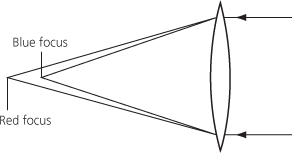See aberration.
False colour in a refracting optical system, arising because light of different wavelengths is refracted by different amounts. The most common example is the coloured fringes that appear round images produced by a simple lens. Red light is refracted less than blue light, so the red focus lies farther from a lens than the blue focus. An image which is in focus in yellow light will therefore have a red fringe. The longer the focal ratio of a lens, the less chromatic aberration it will show. Early telescopes were made with very long focal ratios for this reason. The achromatic lens was invented to overcome chromatic aberration.
chromatic aberration:

A lens brings blue light to a shorter focus than red light.
- loosely coupled multiprocessor
- LOPA
- Lopez-Alegria, Michael Eladio (1958– )
- lophodont
- lophophore
- Lophotrochozoa
- lopolith
- Lopstedt
- LOR
- Lord Appellant
- Lord Lieutenant
- Lord Ordainer
- Lords, House of
- lorem ipsum
- barrow
- Barrow, Isaac
- Barrow, Isaac (1630–77)
- Barrow’s zones
- Barry, Daniel Thomas (1953– )
- BARSC
- barter
- barter economy
- Barthes, Roland (1915–80)
- Barth, Heinrich (1821–65)
- Barth, Karl (1886–1968)